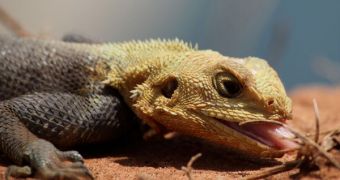Lizards' amazing ability to orient themselves in the field has been long suspected to have something to do with a formation experts have termed their “third eye,” a patch of light-sensitive cells that they have on the side of their heads. According to a series of new experiments, the animals orient themselves with significant accuracy using nothing but the Sun, as they navigate a series of courses in the lab. The third eye was also proven to be directly linked with the way the reptiles processed the circadian rhythm, which tells the difference between night and day, Wired reports.
At the beginning of the experiments, the science team devised a swimming basin, in which they trained the lizards to swim from the center to a hidden ledge, at one of the ends. They then erected a series of walls around the pool, so that the only point of reference the lizards would have was the Sun. After being trained to do so, all lizards were able to find their way to the objective, with nothing to orient themselves to but the relative position of the Sun in the sky. The investigation was conducted by experts from the University of Ferrara, in Italy.
In another study, the lizards were placed in three separate rooms for a week. One of the rooms dimmed and brightened its lights in perfect tune with the passing of night and day in the outside world. The other two either moved faster, or slower, creating a circadian rhythm offset in the lizards of about six hours. When placed in the basin, only the reptiles in the control room managed to swim to the target. The others either swam to the left or to the right, depending on whether they were “ahead” or “behind” schedule. The team inferred that the mistakes occurred because of the disjunctions between where the lizards thought the Sun should be, and where it actually was.
In a scientific paper published in last Friday's issue of the Journal of Experimental Biology, the experts report that, after the third eye was either patched up or removed altogether, the reptiles completely lost their ability to navigate, and swam randomly and aimlessly in the basin. If the findings can be replicated in other lizards and fish as well, they could provide even more support for the third-eye theory, which states that the formation is essential to navigation in most species. Humans too have it, except inside the skull. The formation is essential to our spatial orientation.

 14 DAY TRIAL //
14 DAY TRIAL //